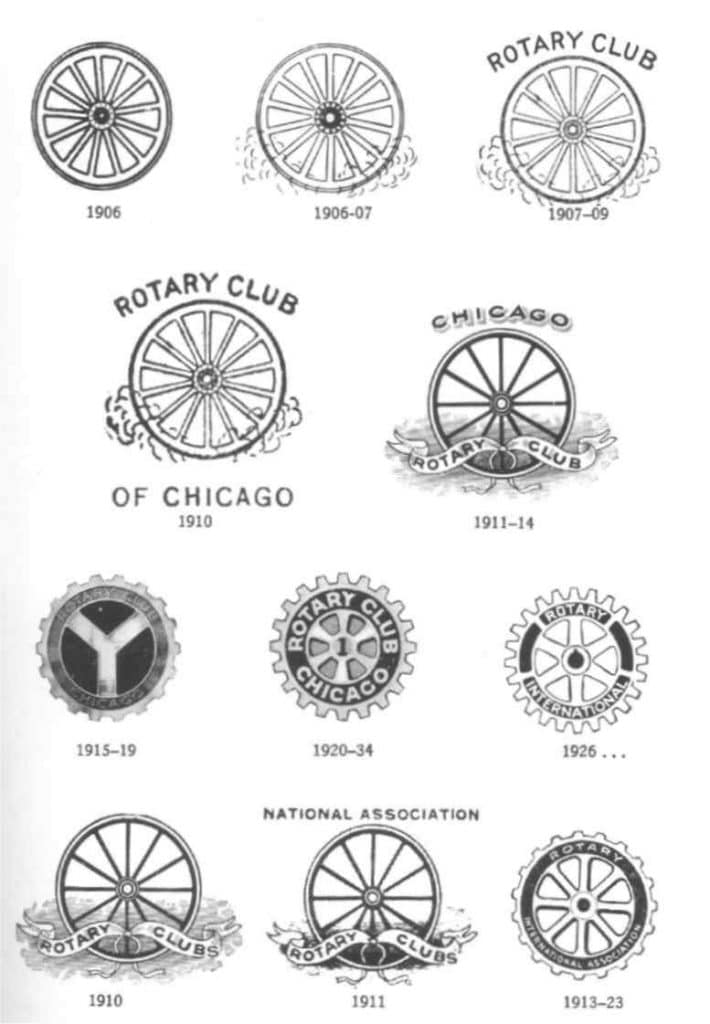The Rotary gearwheels
The following was attributed to the Philadelphia club,
and published by Rotary Club of Bay City, Texas, 2004
The Rotary gearwheel is one of the most familiar symbols in the world today. But for many years, there was no standard Rotary emblem. Rotary clubs designed their own.
In its early years, the Rotary Club of Chicago used a wagon wheel emblem, an idea attributed to Paul Harris, who reasoned that it symbolized civilization and movement. The appearance changed from time to time.
When an engraver joined the club, he offered to design a permanent emblem. Members rejected his first idea—a plain buggy wheel—as looking lifeless and meaningless. To give the appearance of action, the engraver added clouds of dust ahead of and behind the wheel. He also placed the words “Rotary Club” above it. One observant Rotarian pointed out that a wheel would not generate clouds of dust in front of it. He removed the offending cloud and that design remained the emblem for Chicago until about 1912.
At the 1911 national convention in Portland it was suggested that delegates adopt a standard emblem, based upon the wheel, which had become the generally accepted emblem of Rotary clubs. The Board of Directors appointed a committee to come up with a design. Everyone was amazed how quickly the committee acted. They were appointed in August and had the emblem ready in September. All they did was copy the emblem used by the Rotary Club of Philadelphia.
The Philadelphia club had been chartered in 1910 as the 19th club in the world. [Bay City was the 134th club in 1915] The Philadelphians thought that the Chicago wagon wheel design did not convey the Rotary idea very well. They added cogs to create a working wheel, symbolizing the members working together, literally interlocked with one another to achieve the organization’s objectives. They used 19 cogs in honor of their club. The club started producing metal lapel pins in 1910 with this design for its members to wear on their coats. Today, the millions of pins worn by Rotarians around the world had their genesis in the minds of a club president and a jeweler in Philadelphia in 1910.
The 1912 Rotary convention in Duluth approved the Philadelphia design for the whole organization. To ensure uniformity, the club’s name was replaced by the association’s name, Rotary International. It probably didn’t hurt that the president of the Philadelphia club [who had designed that club’s emblem] became president of the International Association of Rotary Clubs at the Duluth convention.
Even after approval by the convention there was still a divergence in design of the emblem. Many local clubs still had their own wheel. Some wheels had 8 spokes, other had 10, some none at all. Some wheels had 16 gear cogs, some 20, some none. Even the Rotary staff at headquarters was confused. In April 1919, the Rotary wheel on the cover of The Rotarian magazine had 19 cogs. On the May issue’s cover the wheel had 20 cogs. On the June cover it had 27 cogs.
In 1918, a Rotarian engineer from Minnesota petitioned Rotary to amend the design of the wheel. He said that a cogwheel with 19 cogs would not work. He said that the emblem had square-cornered teeth of disproportionate size, that the cogs were irregularly spaced. This Rotarian, Oscar Bjorge, said the emblem was “an insult to engineering that only the brain of an artist could conceive.” So he sketched a new wheel, with 6 spokes [symbolizing the 6 Objects of Rotary at that time] and 24 cogs or teeth. He also added a keyway, which locks a wheel to a hub, thus making it “a worker and not an idler.”
In 1928, the exact specifications of this engineer were written into the Manual of Procedure, approved at the 1929 Dallas convention. The specifications have been unchanged ever since. The geared Rotary wheel appears today throughout the world on millions of lapel pins, flags, ties, jewelry of all sorts, etc. It has been pasted on billboards and postage stamps in more than 100 countries. The Rotary wheel started as an idea in the mind of founder Paul Harris nearly 100 years ago. It remained in its present exact form for 75 years, until 25 August 2013.


